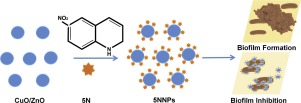当前位置:
X-MOL 学术
›
Colloids Surf. B Biointerfaces
›
论文详情
Our official English website, www.x-mol.net, welcomes your feedback! (Note: you will need to create a separate account there.)
Antibacterial and photocatalytic activities of 5-nitroindole capped bimetal nanoparticles against multidrug resistant bacteria.
Colloids and Surfaces B: Biointerfaces ( IF 5.8 ) Pub Date : 2020-01-24 , DOI: 10.1016/j.colsurfb.2020.110825 Ranjith Kumar Manoharan 1 , Shanmugam Mahalingam 1 , Prakash Gangadaran 2 , Young-Ho Ahn 1
Colloids and Surfaces B: Biointerfaces ( IF 5.8 ) Pub Date : 2020-01-24 , DOI: 10.1016/j.colsurfb.2020.110825 Ranjith Kumar Manoharan 1 , Shanmugam Mahalingam 1 , Prakash Gangadaran 2 , Young-Ho Ahn 1
Affiliation

|
The emergence of antibiotic resistance to commercially- available antibiotics is becoming a major health crisis worldwide. Non-antibiotic strategies are needed to combat biofilm-associated infectious diseases caused by multidrug resistant (MDR) bacterial pathogens. In this study, MBR1 was isolated from a membrane bioreactor used in wastewater treatment plants, and the resistance profile was explored. 5-Nitroindole (5 N)-capped CuO/ZnO bimetal nanoparticles (5 NNP) were synthesized using a one pot method to improve the antibacterial and antibiofilm activities of 5 N against Gram-negative (Escherichia coli ATCC700376 and Pseudomonas aeruginosa PA01) and positive (Staphylococcus aureus ATCC6538) human pathogens. 5 NNP containing 1 mM of 5 N exhibited strong antibacterial and antibiofilm properties to most MDR bacteria. In addition, the photocatalytic activity of CuO/ZnO reduced bacterial cell growth by 1.8 log CFU/mL maximum when exposed to visible light. Scanning electron microscopy showed that 5 NNP reduced the cell density and biofilm attachment of MBR1 by >90% under static conditions. In addition to the antimicrobial and antibiofilm activities, 5 NNP inhibited the persister cell formation of MDR bacterial strains P. aeruginosa, MBR1, E. coli and S. aureus. Therefore, it is speculated that 5 NNP potentially inhibits biofilm and persister cells; hence, 5 NNP could be an alternative agent to combat MDR infectious diseases using a non-antibiotic therapeutic approach.
中文翻译:

5-硝基吲哚封端的双金属纳米颗粒对耐多药细菌的抗菌和光催化活性。
对市售抗生素产生抗药性正在成为全球范围内的主要健康危机。需要非抗生素策略来对抗由多药耐药性(MDR)细菌病原体引起的与生物膜相关的传染病。在这项研究中,MBR1是从用于废水处理厂的膜生物反应器中分离出来的,并研究了其耐药性。使用一锅法合成5-硝基吲哚(5 N)封端的CuO / ZnO双金属纳米颗粒(5 NNP),以提高5 N对革兰氏阴性菌(大肠杆菌ATCC700376和铜绿假单胞菌PA01)和阳性菌的抗菌和生物膜活性。 (金黄色葡萄球菌ATCC6538)人类病原体。含有1 mM的5 N的5 NNP对大多数MDR细菌表现出很强的抗菌和抗生物膜特性。此外,当暴露在可见光下时,CuO / ZnO的光催化活性使细菌细胞的生长减少了最大1.8 log CFU / mL。扫描电子显微镜显示,在静态条件下,5 NNP使MBR1的细胞密度和生物膜附着降低了90%以上。除了抗菌和生物膜活性外,5 NNP还抑制了MDR细菌菌株铜绿假单胞菌,MBR1,大肠杆菌和金黄色葡萄球菌的持久性细胞形成。因此,推测5 NNP可能抑制生物膜和持久性细胞。因此,使用一种非抗生素治疗方法,5 NNP可能是对抗MDR传染病的替代药物。扫描电子显微镜显示,在静态条件下,5 NNP使MBR1的细胞密度和生物膜附着降低了90%以上。除了抗菌和生物膜活性外,5 NNP还抑制了MDR细菌菌株铜绿假单胞菌,MBR1,大肠杆菌和金黄色葡萄球菌的持久性细胞形成。因此,推测5 NNP可能抑制生物膜和持久性细胞。因此,使用一种非抗生素治疗方法,5 NNP可能是对抗MDR传染病的替代药物。扫描电子显微镜显示,在静态条件下,5 NNP使MBR1的细胞密度和生物膜附着降低了90%以上。除了抗菌和生物膜活性外,5 NNP还抑制了MDR细菌菌株铜绿假单胞菌,MBR1,大肠杆菌和金黄色葡萄球菌的持久性细胞形成。因此,推测5 NNP可能抑制生物膜和持久性细胞。因此,使用一种非抗生素治疗方法,5 NNP可能是对抗MDR传染病的替代药物。
更新日期:2020-01-24
中文翻译:

5-硝基吲哚封端的双金属纳米颗粒对耐多药细菌的抗菌和光催化活性。
对市售抗生素产生抗药性正在成为全球范围内的主要健康危机。需要非抗生素策略来对抗由多药耐药性(MDR)细菌病原体引起的与生物膜相关的传染病。在这项研究中,MBR1是从用于废水处理厂的膜生物反应器中分离出来的,并研究了其耐药性。使用一锅法合成5-硝基吲哚(5 N)封端的CuO / ZnO双金属纳米颗粒(5 NNP),以提高5 N对革兰氏阴性菌(大肠杆菌ATCC700376和铜绿假单胞菌PA01)和阳性菌的抗菌和生物膜活性。 (金黄色葡萄球菌ATCC6538)人类病原体。含有1 mM的5 N的5 NNP对大多数MDR细菌表现出很强的抗菌和抗生物膜特性。此外,当暴露在可见光下时,CuO / ZnO的光催化活性使细菌细胞的生长减少了最大1.8 log CFU / mL。扫描电子显微镜显示,在静态条件下,5 NNP使MBR1的细胞密度和生物膜附着降低了90%以上。除了抗菌和生物膜活性外,5 NNP还抑制了MDR细菌菌株铜绿假单胞菌,MBR1,大肠杆菌和金黄色葡萄球菌的持久性细胞形成。因此,推测5 NNP可能抑制生物膜和持久性细胞。因此,使用一种非抗生素治疗方法,5 NNP可能是对抗MDR传染病的替代药物。扫描电子显微镜显示,在静态条件下,5 NNP使MBR1的细胞密度和生物膜附着降低了90%以上。除了抗菌和生物膜活性外,5 NNP还抑制了MDR细菌菌株铜绿假单胞菌,MBR1,大肠杆菌和金黄色葡萄球菌的持久性细胞形成。因此,推测5 NNP可能抑制生物膜和持久性细胞。因此,使用一种非抗生素治疗方法,5 NNP可能是对抗MDR传染病的替代药物。扫描电子显微镜显示,在静态条件下,5 NNP使MBR1的细胞密度和生物膜附着降低了90%以上。除了抗菌和生物膜活性外,5 NNP还抑制了MDR细菌菌株铜绿假单胞菌,MBR1,大肠杆菌和金黄色葡萄球菌的持久性细胞形成。因此,推测5 NNP可能抑制生物膜和持久性细胞。因此,使用一种非抗生素治疗方法,5 NNP可能是对抗MDR传染病的替代药物。


























 京公网安备 11010802027423号
京公网安备 11010802027423号